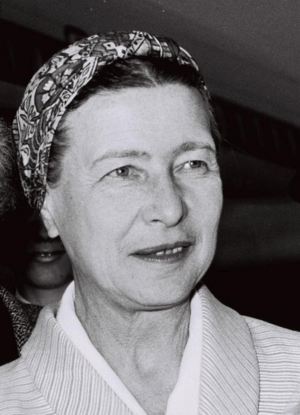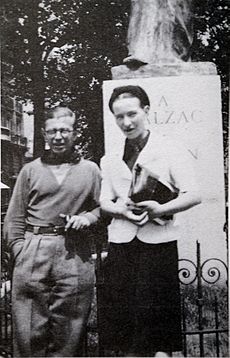Simone de Beauvoir facts for kids
Quick facts for kids
Simone de Beauvoir
|
|
|---|---|

Beauvoir in 1967
|
|
| Born |
Simone Lucie Ernestine Marie Bertrand de Beauvoir
9 January 1908 Paris, France
|
| Died | 14 April 1986 (aged 78) Paris, France
|
| Education | University of Paris (BA, MA) |
|
Notable work
|
The Second Sex (1949) |
| Partner(s) |
|
|
Philosophy career |
|
| Era | 20th-century philosophy |
| Region | Western philosophy |
| School |
|
|
Main interests
|
|
|
Notable ideas
|
|
| Signature | |
Simone Lucie Ernestine Marie Bertrand de Beauvoir ( 9 January 1908 – 14 April 1986) was a French philosopher, writer, social theorist, and feminist activist.
Beauvoir wrote novels, essays, biographies, autobiographies, and monographs on philosophy, politics, and social issues. She was best known for her work, The Second Sex (1949), a detailed analysis of women's oppression and a foundational tract of contemporary feminism. She was also known for her novels, the most famous of which were She Came to Stay (1943) and The Mandarins (1954).
Contents
Early years
Beauvoir was born on 9 January 1908, into a bourgeois Parisian family in the 6th arrondissement. Her parents were Georges Bertrand de Beauvoir, a lawyer who once aspired to be an actor, and Françoise Beauvoir (née Brasseur), a wealthy banker's daughter and devout Catholic. Simone had a sister, Hélène, who was born two years later, on June 6, 1910. The family struggled to maintain their bourgeois status after losing much of their fortune shortly after World War I, and Françoise insisted the two daughters be sent to a prestigious convent school.
Beauvoir was intellectually precocious, fueled by her father's encouragement; he reportedly would boast, "Simone thinks like a man!" Because of her family's straitened circumstances, she could no longer rely on her dowry, and like other middle-class girls of her age, her marriage opportunities were put at risk. She took this opportunity to take steps towards earning a living for herself.
She first worked with Maurice Merleau-Ponty and Claude Lévi-Strauss, when all three completed their practice teaching requirements at the same secondary school. Although not officially enrolled, she sat in on courses at the École Normale Supérieure in preparation for the agrégation in philosophy, a highly competitive postgraduate examination that serves as a national ranking of students. It was while studying for it that she met École Normale students Jean-Paul Sartre, Paul Nizan, and René Maheu (who gave her the lasting nickname "Castor", or "beaver"). The jury for the agrégation narrowly awarded Sartre first place instead of Beauvoir, who placed second and, at age 21, was the youngest person ever to pass the exam. Additionally, Beauvoir finished an exam for the certificate of "General Philosophy and Logic" second to Simone Weil. Her success as the eighth woman to pass the agrégation solidified her economic independence and furthered her feminist ideology.
Education
Beauvoir pursued post-secondary education after completing her high school years at Cours Desir. After passing baccalaureate exams in mathematics and philosophy at the age of seventeen in 1925, she studied mathematics at the Institut Catholique de Paris and literature/languages at the Institut Sainte-Marie. She then studied philosophy at the Sorbonne and after completing her degree in 1928, wrote her Diplôme d'Études Supérieures Spécialisées (roughly equivalent to an M.A. thesis) on Leibniz for Léon Brunschvicg (the topic was "Le concept chez Leibniz" ["The Concept in Leibniz"]). Her studies of political philosophy through university influenced her to start thinking of societal concerns.
Beauvoir was raised in a Catholic household. In her youth, she was sent to convent schools. She was deeply religious as a child, at one point intending to become a nun. At age 14, Beauvoir questioned her faith as she saw many changes in the world after witnessing tragedies throughout her life. Consequently, she abandoned her faith in her early teens and remained an atheist for the rest of her life. To explain her atheist beliefs, Beauvoir stated, "Faith allows an evasion of those difficulties which the atheist confronts honestly. And to crown all, the believer derives a sense of great superiority from this very cowardice itself."
Middle years
From 1929 through 1943, Beauvoir taught at the lycée level until she could support herself solely on the earnings of her writings. She taught at the Lycée Montgrand (Marseille), the Lycée Jeanne-d'Arc (Rouen), and the Lycée Molière (Paris) (1936–39).
Personal life
Beauvoir and Jean-Paul Sartre met during her college years. In October 1929, Jean-Paul Sartre and Beauvoir became a couple for the next 51 years, until his death in 1980.
Death
Beauvoir died of pneumonia on 14 April 1986 in Paris, aged 78. She is buried next to Sartre at the Montparnasse Cemetery in Paris. She was honored as a figure at the forefront of the struggle for women's rights around the time of her passing.
Legacy
Simone de Beauvoir's The Second Sex is considered a foundational work in the history of feminism. Beauvoir had denied being feminist multiple times but ultimately admitted that she was one after The Second Sex became crucial in the world of feminism.
In Paris, Place Jean-Paul-Sartre-et-Simone-de-Beauvoir is a square where Beauvoir's legacy lives on. It is one of the few squares in Paris to be officially named after a couple. The pair lived close to the square at 42 rue Bonaparte.
Prizes
- Prix Goncourt, 1954
- Jerusalem Prize, 1975
- Austrian State Prize for European Literature, 1978
Works
List of publications (non-exhaustive)
- L'Invitée (1943) (English – She Came to Stay) [novel]
- Pyrrhus et Cinéas (1944) [nonfiction]
- Le Sang des autres (1945) (English – The Blood of Others) [novel]
- Les Bouches inutiles (1945) (English - Who Shall Die?) [drama]
- Tous les hommes sont mortels (1946) (English: All Men Are Mortal) [novel]
- Pour une morale de l'ambiguïté (1947) (English: The Ethics of Ambiguity) [nonfiction]
- America Day by Day (1948) (English, 1999): Carol Cosman (Translator) and Douglas Brinkley (Foreword) [nonfiction]
- Le Deuxième Sexe (1949) (English: The Second Sex) [nonfiction]
- L'Amérique au jour le jour (1954) (English: America Day by Day)
- Les Mandarins (1954) (English: The Mandarins) [novel]
- Must We Burn Sade? (1955)
- The Long March (1957) [nonfiction]
- Memoirs of a Dutiful Daughter (1958)
- The Prime of Life (1960)
- Force of Circumstance (1963)
- A Very Easy Death (1964) (French: Une Mort Tres Douce)
- Les Belles Images (1966) [novel]
- The Woman Destroyed (1967) [short stories] (French: La Femme Rompue)
- The Coming of Age (1970) [nonfiction]
- All Said and Done (1972)
- Old Age (1972) [nonfiction]
- When Things of the Spirit Come First (1979) [novel]
- Adieux: A Farewell to Sartre (1981)
- Letters to Sartre (1990)
- A Transatlantic Love Affair: Letters to Nelson Algren (1998)
- Philosophical Writings (2004)
- Journal de guerre, Sept 1939 – Jan 1941 (1990); English – Wartime Diary (2009)
- Diary of a Philosophy Student, 1926–27 (2006)
- Cahiers de jeunesse, 1926–1930 (2008)
- Inseparable (2020)
Images for kids
-
Simone de Beauvoir and Jean-Paul Sartre in Beijing, 1955
-
Dunes cottage where Algren and Beauvoir summered in Miller Beach, Indiana
-
Antonio Núñez Jiménez, Beauvoir, Sartre and Che Guevara in Cuba, 1960.
See also
 In Spanish: Simone de Beauvoir para niños
In Spanish: Simone de Beauvoir para niños







